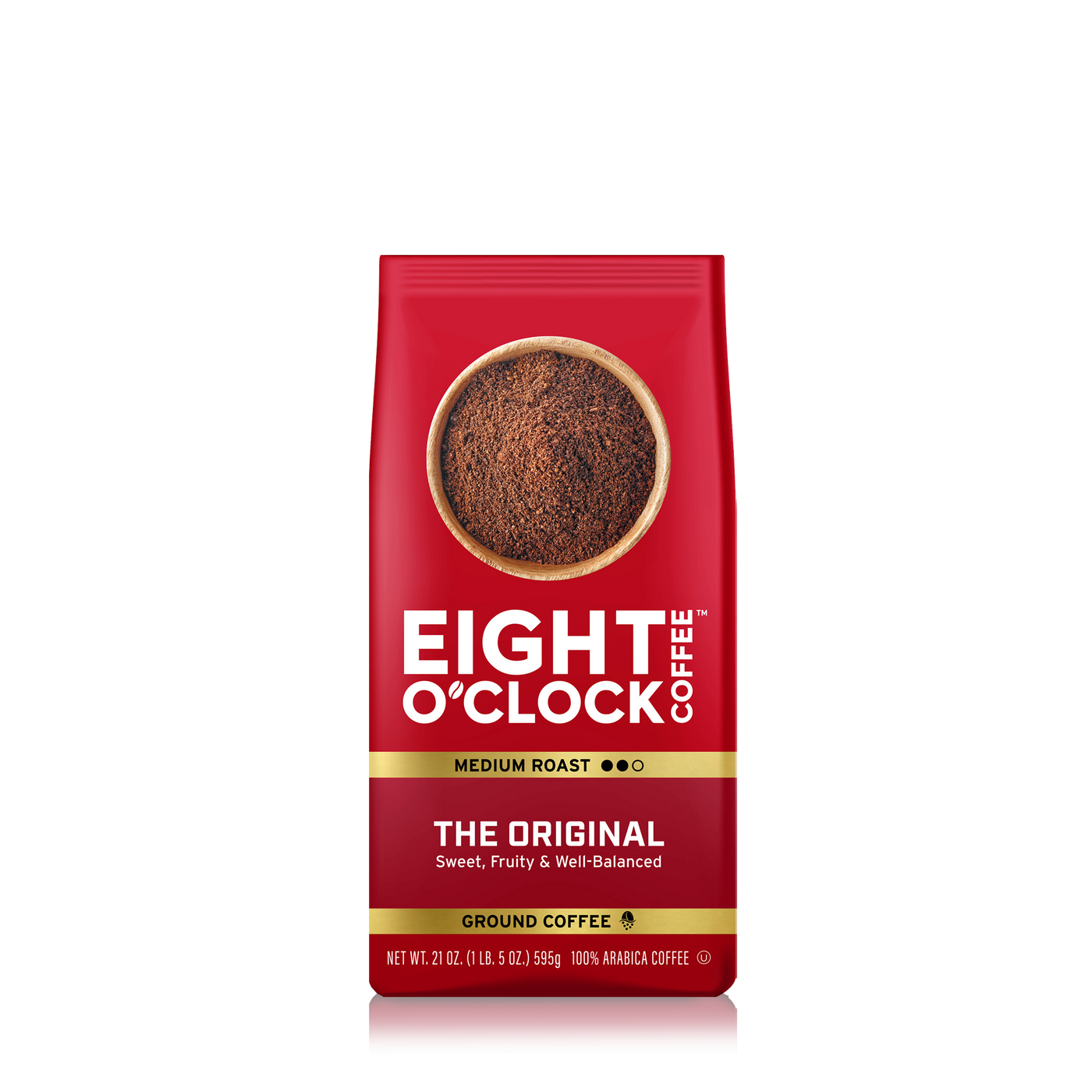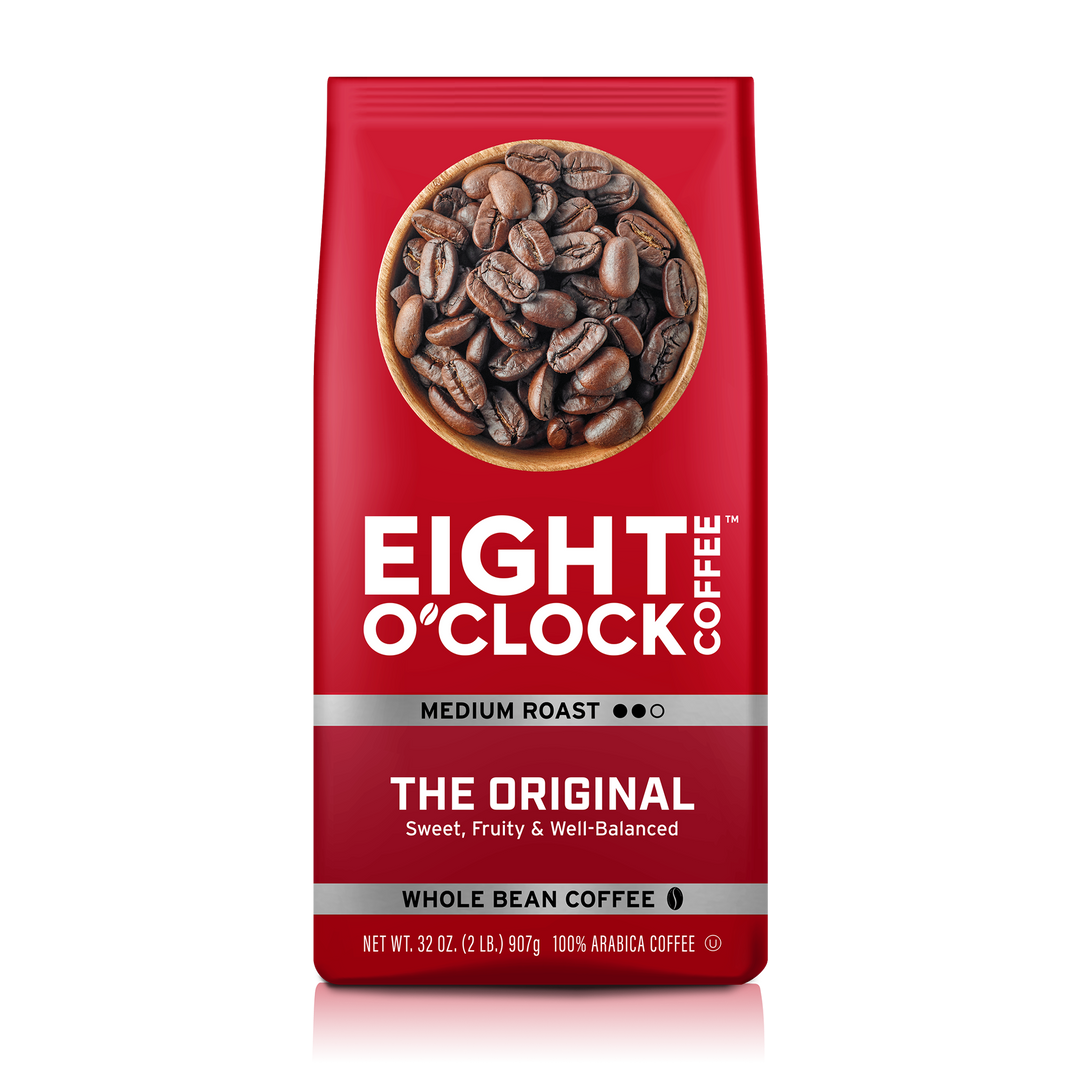As an Amazon Associate CoffeeXplore.com earns from qualifying purchases.
Is Eight O’Clock Coffee Good? A Balanced Review
Wondering if that familiar red bag of Eight O’Clock Coffee sitting on the supermarket shelf is actually good? You’re not alone. Finding a coffee that tastes great without breaking the bank can feel like searching for a needle in a haystack. Many shoppers grab it because it’s affordable and ubiquitous, but then wonder if they’re sacrificing quality for convenience. Does “America’s Original Gourmet Coffee” live up to its name, or is it just another mass-market blend?
Eight O’Clock Coffee is generally considered good for its price point, offering a smooth, widely available coffee made from 100% Arabica beans. Quality can vary between blends, with options like the 100% Colombian Peaks often receiving positive reviews, while the Original blend has faced criticism for inconsistency.
Navigating the world of coffee, from bean types to roast levels and brewing methods, can be confusing. You want a reliable, enjoyable cup to start your day, but you’re wary of bland, bitter, or even defective beans often found in budget-friendly options. In this deep dive, we’ll dissect Eight O’Clock Coffee, exploring its long history, ownership changes, bean quality, flavor profiles of popular blends, how it stacks up against competitors, and what real customers think. Stick around, and you’ll know exactly whether Eight O’Clock Coffee deserves a spot in your shopping cart.
Key Facts:
* Long History: Eight O’Clock Coffee originated in 1919 with the Great Atlantic & Pacific Tea Company (A&P supermarket chain), making it one of America’s oldest coffee brands. (Coffee Review)
* Tata Ownership: Since 2005, the brand has been owned by Tata Coffee, a large, vertically integrated coffee company based in India known for its extensive coffee operations. (Coffee Review)
* 100% Arabica: Unlike many budget brands that use Robusta beans or blends, Eight O’Clock Coffee emphasizes its use of 100% Arabica beans, generally known for a smoother, more nuanced flavor. (Eight O’Clock Coffee, Coffee Review)
* Value Proposition: A core part of its appeal is offering whole-bean, all-Arabica coffee at prices competitive with lower-quality canned coffees, aiming for value and accessibility. (Coffee Review)
* Blend Variety & Inconsistency: While offering various blends (Original, Colombian, French Roast, etc.), reviews suggest quality can be inconsistent, particularly with the Original blend, which has received both praise and harsh criticism over the years. (Coffee Review – Original Blend, Coffee Review – Colombian Blend)
What Exactly is Eight O’Clock Coffee? A Look at its History and Reputation
Eight O’Clock Coffee is one of America’s oldest and most recognizable coffee brands, first introduced in 1919 by the A&P supermarket chain. Now owned by Tata Coffee, it has built a reputation for providing affordable, widely accessible coffee made exclusively from 100% Arabica beans. Its bright red bags are a familiar sight in grocery stores across the country, representing over a century of coffee history.
The brand’s longevity speaks volumes about its enduring appeal, primarily rooted in its value proposition. From its inception, it aimed to offer a higher quality experience (whole bean, Arabica) than typical budget coffees of the time. This focus on balancing affordability with decent quality has allowed it to maintain a strong presence in the competitive coffee market for decades.

From A&P Exclusive to Supermarket Staple
For much of its history, Eight O’Clock Coffee was synonymous with the A&P supermarket chain. It was A&P’s flagship house brand, originally sold as whole beans that customers could grind in-store – a novel concept at the time that emphasized freshness. Named after a popular A&P shopping hour (8 AM and 8 PM), the brand quickly gained popularity.
As A&P grew into one of the largest retail chains in the US, so did the reach of Eight O’Clock Coffee. Even after A&P’s decline and eventual closure, the coffee brand had established such a strong identity and loyal following that it successfully transitioned beyond being an exclusive house brand. It secured distribution in other major supermarkets nationwide, becoming the familiar staple we know today.
The Tata Coffee Era: What Changed?
Tata Coffee, a large Indian company known for its integrated coffee operations (owning estates, processing, exporting, and roasting), has owned and manufactured Eight O’Clock Coffee since acquiring the brand from A&P’s successor company in 2005. This acquisition marked a significant shift, bringing the historic American brand under the umbrella of a global coffee player.
What did this mean for the coffee itself? Tata Coffee largely maintained the brand’s core identity: focusing on 100% Arabica beans and maintaining its affordable price point. They leverage their vertical integration to manage supply chains and production costs effectively. While the ownership changed, the fundamental promise of Eight O’Clock – a decent cup of Arabica coffee at a good price – remained the strategic focus, ensuring its continued presence on supermarket shelves.
So, Is Eight O’Clock Coffee Good? A Balanced Look at Quality
Eight O’Clock Coffee is generally considered good for its price, offering smooth, 100% Arabica coffee that’s accessible and budget-friendly. However, its quality isn’t uniform across all blends; highly-rated options like the 100% Colombian Peaks contrast with the Original blend, which has faced criticism for inconsistency. It represents a solid value proposition for everyday coffee drinkers.
The answer isn’t a simple yes or no. “Good” depends heavily on your expectations and what you compare it to. Compared to instant coffee or cheap canned Robusta blends? Yes, Eight O’Clock’s use of 100% Arabica generally offers a significant step up in smoothness and flavor profile. Compared to freshly roasted, single-origin beans from a specialty roaster? No, it typically lacks that level of complexity, nuance, and peak freshness.
Think of it as a reliable workhorse coffee. It delivers a consistent (mostly), mild, and pleasant coffee experience that satisfies the need for a caffeine boost without unpleasant bitterness, all at a very competitive price. Its strength lies in its value and accessibility.
The Arabica Advantage: Why Bean Choice Matters
Eight O’Clock Coffee uses 100% Arabica beans, which are widely regarded as superior in flavor quality to the alternative, Robusta beans. This choice typically results in a smoother, sweeter, and more aromatic cup with less bitterness compared to many other budget-friendly coffee brands that often rely on cheaper Robusta beans or blends.
Arabica beans naturally contain more complex sugars and lipids, contributing to a wider range of potential flavor notes (fruity, floral, chocolaty, nutty) and a more pleasant acidity. Robusta beans, while hardier and containing more caffeine, tend to produce a bolder, harsher, more bitter flavor, often described as rubbery or burnt. By sticking exclusively to Arabica, Eight O’Clock positions itself above the lowest tier of grocery store coffee, aiming for a baseline level of quality associated with better taste.
Key Takeaway: The commitment to 100% Arabica beans is a significant factor in why many consider Eight O’Clock Coffee “good” for its price category. It provides a smoother, less harsh foundation than many competitors.
Mass Production vs. Freshness: Managing Expectations
It’s crucial to understand that Eight O’Clock is a mass-market brand. The coffee is roasted, packaged, and distributed on a massive scale to supply supermarkets nationwide. This inherently involves trade-offs, primarily concerning freshness.
Unlike specialty coffee roasters who often roast in small batches and ship directly, Eight O’Clock coffee might sit in warehouses and on store shelves for weeks or months before reaching your cup. While packaging technology (like valve bags) helps preserve freshness to some extent, it simply won’t match the vibrant flavors of beans roasted just days or weeks ago. Furthermore, achieving consistency across millions of bags can sometimes lead to variations or, occasionally, the inclusion of lower-quality beans to meet volume demands, which might explain some reports of inconsistency, especially in the flagship Original blend.
Therefore, while the Arabica beans provide potential, the realities of mass production mean you should manage expectations regarding peak freshness and nuanced flavor complexity.
How Do Popular Eight O’Clock Blends Taste? A Flavor Breakdown
Eight O’Clock offers a variety of blends and roasts, each with its own intended flavor profile. While individual experiences can vary, here’s a look at some of the most popular options based on brand descriptions and aggregated reviews:

The Original Blend: An Inconsistent Classic?
Reviews for Eight O’Clock Original Blend are notably mixed and often point to inconsistency. While some drinkers find it delivers sweet, fruity notes and a balanced, medium-roast finish at an unbeatable price, numerous reports, including a harsh 2003 review from Coffee Review, have criticized batches for unpleasant, defective flavors reminiscent of mildew or compost.
This is the brand’s flagship and often its most affordable offering. When it’s good, users describe it as smooth, mild, and slightly sweet – a classic, easy-drinking cup. However, the significant number of negative experiences reported over the years cannot be ignored. The Coffee Review assessment, though dated, described one sample as “outright and unmistakably flavor-defective,” smelling like a “summer sewer” with “bitterly sharp mildew tones.” While likely an extreme example, it highlights the potential variability. Buying the Original blend seems to be a bit of a gamble – you might get a perfectly pleasant, affordable coffee, or you might encounter off-flavors.
100% Colombian Peaks: A Reliable Choice?
The Eight O’Clock 100% Colombian Peaks blend generally receives more consistently positive reviews and is often considered one of the brand’s best offerings. It’s known for its well-balanced, medium-bodied profile featuring delicate cherry, chocolate, and tart orange notes, complemented by integrated acidity and a smooth, silky mouthfeel.
Coffee Review awarded this blend a strong 90 points back in 2008, praising its “delicate but lush, crisp yet voluptuous” character. Consumers often echo this sentiment, finding it a reliable, flavorful, and smooth cup that represents excellent value. It typically delivers the bright acidity and fruity/nutty notes characteristic of good Colombian coffees, making it a popular choice for those seeking a step up from the Original blend without venturing into significantly higher price points. If you’re trying Eight O’Clock for the first time, the Colombian Peaks is often recommended as a safer bet for a positive experience.
Other Notable Blends (French Roast, Dark Italian, Brazilian Breakfast)
Beyond the Original and Colombian, Eight O’Clock offers several other options catering to different preferences:
- French Roast: A dark roast intended to deliver bold, intense flavors with smoky undertones. Generally suits those who prefer a darker, less acidic cup.
- Dark Italian Espresso: An even darker roast specifically marketed for espresso use, aiming for a rich, full-bodied, and chocolaty profile suitable for espresso machines or Moka pots.
- Brazilian Breakfast: Typically a medium roast highlighting the nutty, sweet, and low-acidity characteristics often associated with Brazilian coffees. Aims for a smooth, mellow start to the day.
- Flavored Coffees: They also offer a range of flavored options like Hazelnut and French Vanilla for those who enjoy artificially flavored brews.
The quality and reception of these other blends can also vary, but they offer alternatives for drinkers seeking specific roast levels or flavor profiles within the Eight O’Clock family.
Check out this video review for another perspective:
How Does Eight O’Clock Coffee Compare to Other Brands?
Understanding where Eight O’Clock sits in the broader coffee landscape helps clarify its value and appeal. How does it stack up against common grocery store rivals and premium options?
Eight O’Clock vs. Folgers: Which Offers Better Value?
Compared to Folgers, Eight O’Clock Coffee often holds an edge for those prioritizing bean quality, as it typically uses 100% Arabica beans, whereas Folgers frequently incorporates Robusta beans into its blends. This generally gives Eight O’Clock a smoother, less bitter taste profile at a similar budget-friendly price point, arguably offering better value in terms of bean type.
Both are iconic American coffee brands found in nearly every supermarket. Folgers, known for its classic red tub, often relies on Arabica/Robusta blends to keep costs extremely low and deliver a bold, strong flavor profile that many traditional coffee drinkers prefer. Eight O’Clock’s commitment to 100% Arabica usually results in a milder, smoother cup. If your primary concern is avoiding the harshness sometimes associated with Robusta, Eight O’Clock might be the preferable budget option. However, taste is subjective, and loyal Folgers drinkers may prefer its bolder character.
Eight O’Clock vs. Starbucks: Budget vs. Premium
Eight O’Clock Coffee and Starbucks operate in different segments of the market; Eight O’Clock is a budget-friendly grocery brand offering milder, classic coffee flavors, while Starbucks is a premium brand known for its bolder, often darker roasts, cafe experience, and significantly higher price point.
There’s little direct comparison in terms of target audience or product positioning. Starbucks often emphasizes dark roasts (though they offer lighter options too) and a strong, distinct flavor profile associated with their cafe beverages. Eight O’Clock provides a more traditional, less intense coffee experience at a fraction of the cost. If you enjoy the Starbucks roast profile, Eight O’Clock might taste underdeveloped or weak in comparison. Conversely, if you find Starbucks coffee too bitter or “burnt,” Eight O’Clock’s smoother, milder profile might be more appealing. They cater to fundamentally different budgets and taste preferences.
Eight O’Clock vs. Specialty Coffee Roasters
The gap between Eight O’Clock and specialty coffee roasters is significant. Specialty coffee focuses on high-quality, often single-origin beans, meticulous roasting in small batches to highlight unique flavor nuances, and prioritizing freshness above all else.
Eight O’Clock, as a mass-market brand, cannot realistically compete on these fronts. Its coffee is blended for consistency (though sometimes failing, as noted), roasted on an industrial scale, and distributed through conventional retail channels, meaning freshness is compromised compared to beans roasted days or weeks ago by a local or online specialty roaster. Specialty coffee offers far greater complexity, clarity of flavor, and traceability, but comes at a considerably higher price. Eight O’Clock provides accessibility and affordability; specialty coffee provides peak quality and nuanced flavor experiences.
Tip: If you enjoy Eight O’Clock but are curious about exploring more complex flavors, trying a medium roast single-origin coffee (like a Colombian or Brazilian) from a reputable specialty roaster could be an interesting next step.
What are Key Characteristics of Eight O’Clock Coffee?
Beyond the general quality and taste, consumers often have specific questions about attributes like acidity, caffeine content, and brewing suitability.
Is Eight O’Clock Coffee Acidic?
Eight O’Clock Coffee is generally considered to have low to moderate acidity, often described by drinkers as smooth, mellow, and easy on the stomach. While acidity levels naturally vary slightly by blend and roast level (darker roasts tend to have lower acidity), its reputation is built on being less acidic than many other coffees.
Acidity in coffee refers to the bright, tangy, sometimes fruity notes that add liveliness to the cup – it’s not the same as pH level or being “acidic” in a way that causes heartburn (though perceived acidity can sometimes correlate). Coffees described as having high acidity might taste sharp or sour if unbalanced, while low-acidity coffees can be smooth but sometimes lack vibrancy. Eight O’Clock leans towards the smoother, lower-acidity end of the spectrum, contributing to its broad appeal as an easy-drinking, non-offensive coffee.
How Much Caffeine is in Eight O’Clock Coffee?
Eight O’Clock Coffee contains a standard amount of caffeine for a coffee made from 100% Arabica beans, typically ranging from 95 to 120 milligrams per 8-ounce brewed cup. The exact amount can vary depending on the specific blend, roast level, and brewing method used.
Arabica beans generally contain less caffeine than Robusta beans. Since Eight O’Clock uses only Arabica, its caffeine content is average – not particularly high, nor unusually low (unless you opt for their Decaf or 50% Decaf options). It provides a typical caffeine kick expected from a standard cup of coffee, sufficient for a morning wake-up call or afternoon pick-me-up without being overly potent.
Can You Use Eight O’Clock Coffee for Espresso?
Yes, you can technically use Eight O’Clock Coffee for making espresso, particularly the darker roasts like their Dark Italian Espresso blend. However, you must ensure you are using a fine, consistent grind suitable for espresso machines. While usable, it may not produce the thick crema, body, or flavor complexity expected from beans specifically selected and roasted for espresso.
Mass-market coffees like Eight O’Clock are primarily designed and blended for standard drip brewing methods. While darker roasts can stand up to the pressure and extraction of an espresso machine, they often lack the specific bean characteristics (like density and soluble compounds) that yield optimal espresso shots. You might get a serviceable espresso-like drink, but it likely won’t rival the quality achieved with fresh, specialty espresso beans. If you primarily drink espresso, investing in beans specifically roasted for that purpose is usually recommended.
What Do Real Customers Say? (Reviews and Opinions)
Aggregating feedback from platforms like Amazon, Reddit, and coffee forums provides a snapshot of real-world user experiences with Eight O’Clock Coffee. Sentiment is generally mixed, often reflecting the brand’s value proposition and inconsistencies.
Common Praises: Affordability and Smoothness
Many customers consistently praise Eight O’Clock for its excellent value for money. It’s frequently highlighted as a go-to budget coffee that delivers a satisfying cup without the premium price tag. The smoothness and low acidity are also recurring positive comments. Drinkers appreciate that it’s generally mellow, lacks harsh bitterness, and is easy to drink black or with additions. Its wide availability in most supermarkets is another practical plus. Users on platforms like Reddit often mention it as a reliable “daily driver” coffee.
Common Criticisms: Inconsistency and Freshness Concerns
The most significant and persistent criticism revolves around inconsistency, particularly with the Original blend. Numerous reviews mention noticeable batch-to-batch variations, with some bags tasting great and others being bland, stale, or exhibiting the off-flavors noted by Coffee Review. Freshness is another common concern, inherent to its mass-market distribution model. Compared to locally roasted or direct-shipped coffee, beans can be perceived as stale or lacking aromatic vibrancy. Some users also find the overall flavor profile too mild or uninteresting, especially those accustomed to bolder or more complex specialty coffees.
Who Should (and Shouldn’t) Buy Eight O’Clock Coffee?
Considering its characteristics, price point, and common feedback, Eight O’Clock Coffee appeals most strongly to a specific type of coffee drinker.
Ideal For: The Budget-Conscious Everyday Drinker
Eight O’Clock Coffee is an excellent choice for budget-conscious consumers who prioritize affordability, accessibility, and a consistently smooth, mild-to-medium roast flavor for their daily coffee consumption. If you want a reliable, easy-drinking coffee that won’t break the bank and is readily available at your local supermarket, Eight O’Clock fits the bill.
This coffee is tailor-made for those who need a dependable caffeine source without fuss or fanfare. If you appreciate a classic, non-challenging coffee taste, dislike bitterness, and value getting a large quantity of 100% Arabica beans for a low price, you’ll likely find Eight O’Clock to be a “good” and satisfactory option, especially blends like the 100% Colombian Peaks.
Might Disappoint: The Specialty Coffee Enthusiast
Coffee drinkers who prioritize peak freshness, complex flavor profiles, single-origin nuances, and the craft aspect of small-batch roasting will likely find Eight O’Clock Coffee disappointing. If you actively seek out unique tasting notes, appreciate the vibrant acidity of freshly roasted beans, or are sensitive to potential flavor variations and staleness, this mass-market brand probably won’t meet your expectations.
Those accustomed to the quality and characteristics of specialty coffee will immediately notice the differences in freshness, aroma, and flavor complexity. The potential for inconsistency and the inherent limitations of large-scale production mean Eight O’Clock simply doesn’t operate in the same quality tier. If your coffee journey involves exploring terroir, processing methods, and specific roast profiles, you’re better off investing in beans from specialty roasters.
FAQs About Eight O Clock Coffee
Is Eight O’Clock Coffee considered high quality?
It’s generally considered good quality for its price point within the mass-market segment, primarily due to using 100% Arabica beans. However, it’s not typically classified as “high quality” when compared to specialty coffee standards due to potential inconsistency and lack of peak freshness.
Is Eight O’Clock Coffee better than Folgers?
Many argue yes, primarily because Eight O’Clock uses 100% Arabica beans, leading to a generally smoother taste than Folgers, which often uses Robusta blends. However, taste preference is subjective; some may prefer Folgers’ bolder profile.
How does Eight O’Clock Coffee compare to Starbucks?
They serve different markets. Eight O’Clock is a budget-friendly, milder grocery coffee, while Starbucks is a premium brand with bolder, darker roasts and a higher price. They aren’t direct competitors in terms of taste profile or cost.
What kind of coffee beans does Eight O’Clock use?
Eight O’Clock Coffee exclusively uses 100% Arabica beans across its product line, distinguishing it from many other budget brands that use Robusta or Arabica/Robusta blends.
Is Eight O’Clock Coffee very acidic?
No, it’s generally known for having low to moderate acidity, contributing to its reputation as a smooth and mellow coffee that’s easy on the stomach for most drinkers.
How much caffeine is in Eight O’Clock Coffee?
It contains a standard amount of caffeine for Arabica coffee, roughly 95-120 mg per 8oz cup, though this varies by blend, roast, and brew method. It’s not exceptionally high or low.
Who owns the Eight O’Clock Coffee brand today?
The brand is owned by Tata Coffee, a large, integrated coffee company based in India, which acquired it in 2005.
What’s the difference between Eight O’Clock Original and Colombian blends?
The Original blend aims for a classic, balanced medium roast but has reviews mentioning inconsistency. The 100% Colombian Peaks blend is generally more consistently well-reviewed, offering brighter, fruitier notes (cherry, orange) typical of Colombian coffee and a smoother mouthfeel.
Can I use Eight O’Clock Coffee in an espresso machine?
Yes, especially darker roasts like the Dark Italian Espresso blend, but ensure a fine grind. However, it likely won’t produce the crema or complexity of specialty espresso beans.
Is Eight O’Clock Coffee generally smooth or bitter?
It is generally considered smooth. Its use of 100% Arabica beans and tendency towards medium roasts results in less bitterness compared to many Robusta-based or very dark-roasted coffees.
Summary: The Final Verdict on Eight O’Clock Coffee
Eight O’Clock Coffee ultimately offers a strong value proposition: it delivers a smooth, pleasant, and affordable coffee experience grounded in the quality standard of 100% Arabica beans, making it widely accessible through supermarkets. Its key strengths are its budget-friendly price, general smoothness, low acidity, and the use of better-quality beans than many rivals in its category.
However, it’s not without drawbacks. The main weaknesses lie in potential inconsistency, particularly noted in the Original blend, and the inherent lack of peak freshness and flavor complexity compared to specialty coffees. It’s a mass-market product designed for broad appeal and everyday consumption, not for the discerning palate seeking nuanced, freshly roasted beans.
So, is Eight O’Clock Coffee good? For the average coffee drinker looking for a reliable, affordable, and smooth cup to start their day, the answer is often yes – particularly if choosing blends like the 100% Colombian Peaks. It successfully bridges the gap between low-quality budget options and more expensive premium brands. While it won’t excite the specialty coffee connoisseur, it holds its own as a venerable and dependable supermarket staple.
What are your experiences with Eight O’Clock Coffee? Do you have a favorite blend, or have you encountered inconsistencies? Share your thoughts in the comments below!

